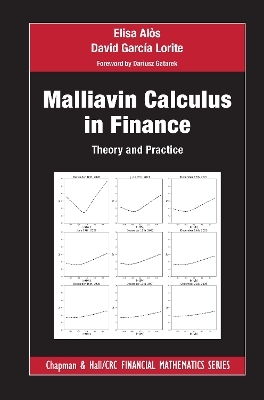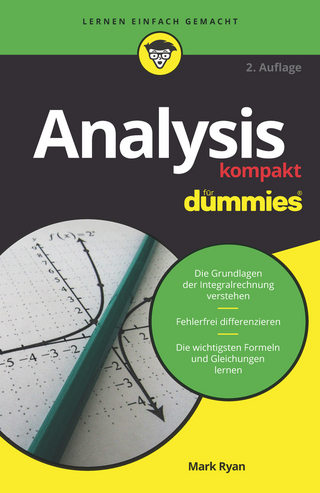
Malliavin Calculus in Finance
Chapman & Hall/CRC (Verlag)
978-0-367-86325-8 (ISBN)
Malliavin Calculus in Finance: Theory and Practice aims to introduce the study of stochastic volatility (SV) models via Malliavin Calculus.
Malliavin calculus has had a profound impact on stochastic analysis. Originally motivated by the study of the existence of smooth densities of certain random variables, it has proved to be a useful tool in many other problems. In particular, it has found applications in quantitative finance, as in the computation of hedging strategies or the efficient estimation of the Greeks.
The objective of this book is to offer a bridge between theory and practice. It shows that Malliavin calculus is an easy-to-apply tool that allows us to recover, unify, and generalize several previous results in the literature on stochastic volatility modeling related to the vanilla, the forward, and the VIX implied volatility surfaces. It can be applied to local, stochastic, and also to rough volatilities (driven by a fractional Brownian motion) leading to simple and explicit results.
Features
Intermediate-advanced level text on quantitative finance, oriented to practitioners with a basic background in stochastic analysis, which could also be useful for researchers and students in quantitative finance
Includes examples on concrete models such as the Heston, the SABR and rough volatilities, as well as several numerical experiments and the corresponding Python scripts
Covers applications on vanillas, forward start options, and options on the VIX.
The book also has a Github repository with the Python library corresponding to the numerical examples in the text. The library has been implemented so that the users can re-use the numerical code for building their examples. The repository can be accessed here: https://bit.ly/2KNex2Y.
Elisa Alòs holds a Ph.D. in Mathematics from the University of Barcelona. She is an Associate Professor in the Department of Economics and Business at Universitat Pompeu Fabra (UPF) and a Barcelona GSE Affiliated Professor. In the last fourteen years, her research focuses on the applications of the Malliavin calculus and the fractional Brownian motion in mathematical finance and volatility modeling. David Garcia Lorite currently works in Caixabank as XVA quantitative analyst and he is doing a Ph.D. at Universidad de Barcelona under the guidance of Elisa Alòs with a focus in Malliavin calculus with application to finance. For the last fourteen years, he has worked in the financial industry in several companies but always working with hybrid derivatives. He has also strong computational skills and he has implemented several quantitative and not quantitative libraries in different languages throughout his career.
I. A primer on option pricing and volatility modeling. 1. The option pricing problem. 1.1. Derivatives. 1.2. Non-arbitrage prices and the Black-Scholes formula. 1.3. The Black-Scholes model. 1.4. The Black-Scholes implied volatility and the non-constant volatility case. 1.5. Chapter's digest. 2. The volatility process. 2.1. The estimation of the integrated and the spot volatility. 2.2. Local volatilities. 2.3. Stochastic volatilities. 2.4. Stochastic-local volatilities 2.5. Models based on the fractional Brownian motion and rough volatilities. 2.6. Volatility derivatives. 2.7. Chapter’s Digest. II. Mathematical tools. 3. A primer on Malliavin Calculus. 3.1. Definitions and basic properties. 3.2. Computation of Malliavin Derivatives. 3.3. Malliavin derivatives for general SV models. 3.4. Chapter's digest. 4. Key tools in Malliavin Calculus. 4.1. The Clark-Ocone-Haussman formula. 4.2. The integration by parts formula. 4.3. The anticipating It^o's formula. 4.4. Chapter’s Digest. 5. Fractional Brownian motion and rough volatilities. 5.1. The fractional Brownian motion. 5.2. The Riemann-Liouville fractional Brownian motion. 5.3. Stochastic integration with respect to the fBm. 5.4. Simulation methods for the fBm and the RLfBm. 5.5. The fractional Brownian motion in finance. 5.6. The Malliavin derivative of fractional volatilities. 5.7. Chapter's digest. III. Applications of Malliavin Calculus to the study of the implied volatility surface. 6. The ATM short time level of the implied volatility. 6.1. Basic definitions and notation. 6.2. The classical Hull and White formula. An extension of the Hull and White formula from the anticipating Itô's formula. 6.4. Decomposition formulas for implied volatilities. 6.5. The ATM short-time level of the implied volatility. 6.6. Chapter's digest. 7. The ATM short-time skew. 7.1. The term structure of the empirical implied volatility surface. 7.2. The main problem and notations. 7.3. The uncorrelated case. 7.4. The correlated case. 7.5. The short-time limit of implied volatility skew. 7.6. Applications. 7.7. Is the volatility long-memory, short memory, or both?. 7.8. A comparison with jump-diffusion models: the Bates model. 7.9. Chapter's digest. 8.0. The ATM short-time curvature. 8.1. Some empirical facts. 8.2. The uncorrelated case. 8.3. The correlated case. 8.4. Examples. 8.5. Chapter's digest. IV. The implied volatility of non-vanilla options. 9. Options with random strikes and the forward smile. 9.1. A decomposition formula for random strike options. 9.2. Forward start options as random strike options. 9.3. Forward-Start options and the decomposition formula. 9.4. The ATM short-time limit of the implied volatility. 9.5. At-the-money skew. 9.6. At-the-money curvature. 9.7. Chapter's digest. 10. Options on the VIX. 10.1. The ATM short time level and skew of the implied volatility. 10.2. VIX options. 10.3. Chapter's digest. Bibliography. Index.
| Erscheinungsdatum | 14.09.2021 |
|---|---|
| Reihe/Serie | Chapman and Hall/CRC Financial Mathematics Series |
| Zusatzinfo | 6 Tables, black and white; 51 Line drawings, black and white; 51 Illustrations, black and white |
| Sprache | englisch |
| Maße | 156 x 234 mm |
| Gewicht | 453 g |
| Themenwelt | Mathematik / Informatik ► Mathematik ► Analysis |
| Mathematik / Informatik ► Mathematik ► Angewandte Mathematik | |
| Wirtschaft ► Betriebswirtschaft / Management ► Finanzierung | |
| ISBN-10 | 0-367-86325-1 / 0367863251 |
| ISBN-13 | 978-0-367-86325-8 / 9780367863258 |
| Zustand | Neuware |
| Informationen gemäß Produktsicherheitsverordnung (GPSR) | |
| Haben Sie eine Frage zum Produkt? |
aus dem Bereich


